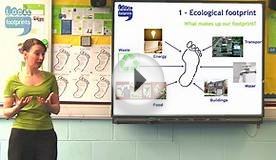What is your Ecological footprint?
 An ecological footprint is the quantity of natural resources (energy, water, land) needed to support our life-styles or businesses. Ecological footprints are often expressed as an area (global hectares), and Australia’s ecological footprint is a staggering 7 global hectares per person. Even if you think you’re an environmental champion, it’s likely that your footprint is still well above the sustainable level for the globe (estimated to be 2.1 global hectares per person with the current global human population).
An ecological footprint is the quantity of natural resources (energy, water, land) needed to support our life-styles or businesses. Ecological footprints are often expressed as an area (global hectares), and Australia’s ecological footprint is a staggering 7 global hectares per person. Even if you think you’re an environmental champion, it’s likely that your footprint is still well above the sustainable level for the globe (estimated to be 2.1 global hectares per person with the current global human population).
You can offset your ecological footprint for as little as $1 a day.
Many factors contribute to a person’s ecological footprint:
- the size of the house;
- the materials used in building the house;
- the extent to which the house is cooled or heated;
- the types of food and beverages consumed;
- the distances the food and beverages travel before being consumed;
- the type and capacity of any car(s) used and the frequency of use;
- the types and numbers of pets;
- the frequency and distances flown in airplanes;
- the amount of clothing purchased; and so on.
Only about 50% of the ecological footprint is the carbon footprint.
A typical Australian has a carbon footprint in the range of 5 to 20 tonnes. Assuming an average price to offset carbon is around $10-20 per tonne, and given that the carbon footprint is about half the ecological footprint, offsetting an individual ecological footprint is likely to be in the range of $200-400 per year or as little as $1 per day. Many of us have lived a number of decades already without offsetting our ecological footprints, so $1 per day should be considered the minimum payment.
$1 a day is equivalent to less than a third of a cup of coffee, less than a third of a bottle of water, just a portion of a chocolate bar or a few mouthfuls of a bottle of wine or beer. We can afford to offset our ecological footprints.


|
Is your lunch causing global warming? Cars and factories are major sources of greenhouse gas emissions that are heating up the planet. But what you ... An article from: New York Times Upfront Book (Scholastic, Inc.) |

|
Wallmonkeys Ecological Footprint Symbol Peel and Stick Wall Decals (24 in W x 16 in H) Home (Wallmonkeys)
|